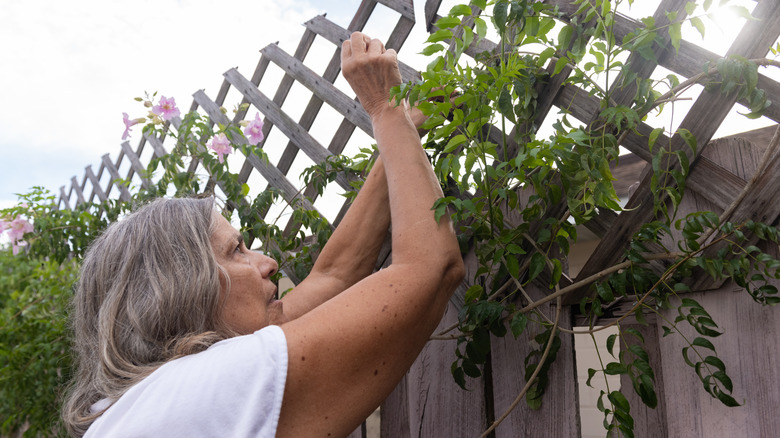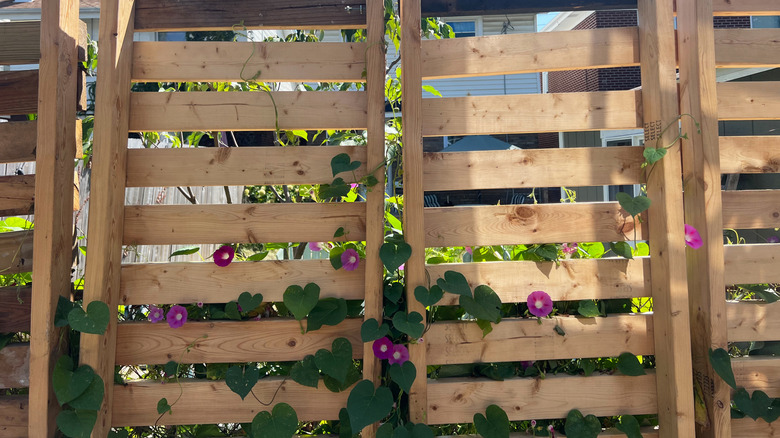How To Train Climbing Plants On A Wood Fence Without Causing Damage
We may receive a commission on purchases made from links.
If you desire the dramatic look of a climbing plant clinging to your fence, be careful before putting that plan into action if the fence is wooden. The storybook garden of your dreams can turn into a structural nightmare if you pick the wrong type of vine or position it incorrectly on your wooden fence. But go with climbing plants that grow annually and have flexible stems that can scale a wood fence or trellis, and you can still incorporate climbing plants that will make you feel like you're living a fairytale. To prevent damage, choose wood-safe plants and use twine to guide them onto the fence, or grow them on a trellis nearby.
Many of the best vines for wood fences climb by wrapping their stems around available supports, so they should be able to simply grow on the fence. That doesn't mean you can't give the plants some direction – tying some twine onto a fence post and twirling the vines around the twine by hand can train them to grow upward. You won't have to leave the string tied around the plant once they've become established climbers. If the vine you chose has tiny tendrils, it might need more training, so getting a trellis with some slender or horizontal elements is a smart idea. Place fences like the LZRS Rustic Iron Garden Trellis to visually group the vines with the fence. For a DIY way to encourage climbing, repurpose extra lattice instead of throwing it out. Whether you're training the vines on a fence post, trellis, or lattice, check on it as it grows and make sure you're untangling stems or tendrils that have strayed. Pick them up and either snake them through the twine or wrap them around a support.
Plants that are perfect for wood fences
The plants that will do well on a trellis (and won't lead to a costly or time-intensive repair by damaging the wood) are herbaceous vines, which have tender and adaptable stems. Choose climbing plants that are annuals rather than perennials, so you can decide not to grow them again next season in case you suspect a problem. If the wood appears to be splitting or discolored or the posts start leaning, these are signs that the vines on your fence are causing major damage. But you should spare yourself from that fate by avoiding woody vines and clinging vines like Virginia creeper (Parthenocissus quinquefolia) — both of which tend to trap moisture onto the fence, wrecking the wood. It's important to avoid invasive plants, which can quickly overtake the whole fence and other parts of your property. But keep in mind that even some native (and pretty) vines like American wisteria (Wisteria frutescens) are woody and can harm the wood by trapping humidity and breeding mold.
You'll achieve the best results by choosing herbaceous annual plants that use thin tendrils for their climbing habit. Some options include morning glory (Ipomoea), annual sweet pea (Lathyrus odoratus), moonflower (Ipomoea alba), and cardinal climber (Ipomoea sloteri), many of which attract hummingbirds, butterflies, and their fellow pollinators. Be aware that if you're planting in a warmer climate, cardinal climber can become hard to manage. Climbing nasturtium (Tropaeolum majus) is also recommended, but its self-seeding nature can cause it to spread beyond the fence. Once you have the right vines growing in the right place, prune them during their growing season, not only to keep them healthy but to ensure they don't spread from the trellis to the fence, or overtake spaces you wanted to keep clear.

